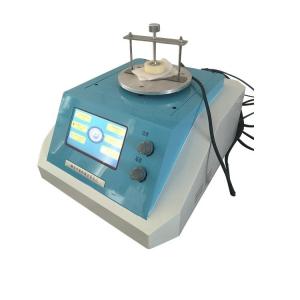

Add to Cart
operation video
Testing object:
Suitable for metal, ceramic, alloy, ore, polymer, composite, paper, fabric, foam (surface-level insulation, sheet), mineral wool, cement wall, glass reinforced composite board CRC, cement polystyrene board, sandwich Concrete, FRP panel composite panels, paper honeycomb panels, colloids, liquids, powders, granules and paste solids, etc., have a wide range of test objects.
Working principle:
Transient planar heat source technology (TPS) is a new method for measuring thermal conductivity, developed by Professor Silas Gustafsson of the University of Technology, Chalmer, Sweden, based on the hotline method. Its principle of determining the thermal properties of a material is based on the transient temperature response produced by a step- heated disk-shaped heat source in an infinite medium. A flat probe is made of a thermally resistive material, and serves as both a heat source and a temperature sensor. The thermal resistance coefficient of the alloy has a linear relationship with the relationship between temperature and resistance. That is, the heat loss can be known by understanding the change of the resistance, thereby reflecting the thermal conductivity of the sample.The continuous double-spiral structure sheet formed by etching after gold etching has a double-layer insulating protective layer and a thin thickness, which makes the probe have a certain mechanical strength and maintain electrical insulation from the sample. During the test, the probe was placed in the middle of the sample for testing. When the current passes through the probe, a certain temperature rise occurs, and the generated heat is simultaneously diffused to the samples on both sides of the probe. The speed of thermal diffusion depends on the heat transfer characteristics of the material. By recording the temperature and the response time of the probe,The thermal conductivity can be directly obtained from the mathematical model.
Technical parameters:
| Test range | 0.005—300W/(m*K) |
| Measuring temperature range | room temperature - 130 ° C |
| Probe diameter | No. 1 probe 7.5mm; No. 2 probe 15mm |
| Accuracy | ±3% |
| Repeatability error | ≤3% |
| Measurement time | 5~160 seconds |
| Power supply | AC 220V |
| Machine power | <500w |
| Sample temperature rise | <15 ° C |
| Test sample power P | No. 1 probe power 0 < P < 1w; No. 2 probe power 0 < P < 14w |
| Sample specifications | Single sample (15*15*3.75mm) measured by the first probe; single sample (30*30*7.5mm) measured by the second probe. |
| Note: The No. 1 probe measures a thin material with a low thickness. The sample is superimposed if the surface of the sample is smooth and flat and sticky. | |
| methods | Transient plane heat source method | laser method | hot-wire technique | guarded plate method |
| not steady state method | not steady state method | not steady state method | steady state method | |
| measuring physical properties | Thermal conductivity and thermal diffusivity are obtained directly. | The thermal diffusivity and specific heat are obtained directly, and the thermal conductivity is calculated by the input sample density value. | Thermal conductivity is obtained directly | Thermal conductivity is obtained directly |
| application range | solid, liquid, powder, paste, colloid, particle | solid | Solid, liquid | solid |
| sample preparation | No special requirements, simple sample preparation. | Sample preparation is multifarious. | Sample preparation is simple and has specific requirements. | Larger sample size. |
| accuracy of measurement | ±3%,better±0.5% | better±10% | better±5% | better±3% |
| physical model | Planar heat source contact measurement, as long as the finite surface contact is good. | The heat source is contactless. | The linear heat source must be in good contact with the linear model. | Heat source contact type, need good surface contact. |
Thermal conductivity range [w/(m*k)] | 0.005-300 | 10-500 | 0.005-10 | 0.005-5 |
| measuring time | 5-160S | few minutes | few minutes | few hours |
